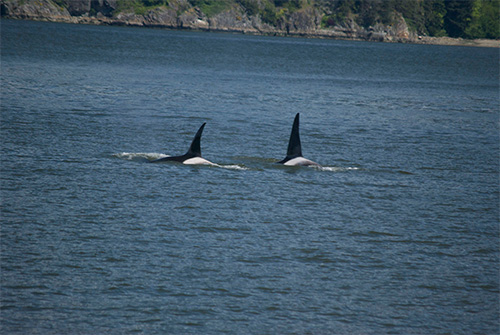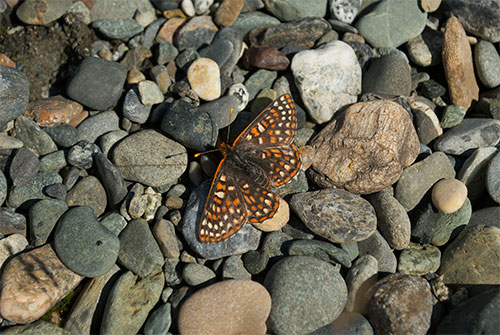
Why the wild things go where they goBy MARIE THOMS
April 20, 2016
University of Alaska Fairbanks scientist Greg Breed studies why wild animals go where they go and live where they live. He and his students follow butterflies, grey and Weddell seals, Cassin’s auklets and golden eagles, in addition to killer whales and narwhals. “We want to know why killer whales are showing up in greater numbers, how they are behaving and how they are affecting the behavior of narwhals and other marine mammals,” said Breed, a movement ecologist at UAF’s Institute of Arctic Biology. Narwhals are typically found far out to sea in waters that are hundreds of meters deep. But when killer whales arrive, local observers say the narwhals appear to be chased to the shore. “Warming Arctic waters and a lack of sea ice appear to be making it easier for killer whales to swim north in search of prey such as the narwhal,” said Breed. “It’s also possible that killer whale populations are rebounding after years of being hunted and what’s being witnessed isn’t new.” Breed’s killer whale-narwhal study came about somewhat serendipitously. “I was working with the Canadian Department of Fisheries and Oceans on ringed seals and they gave me a fantastic data set from GPS-tagged killer whales and narwhals,” he said. “The sample size is small, but it’s unusual and there are no other predator-prey data sets like this.” The data sets included thousands of latitude and longitude positions of the animals over several months’ time. Breed plotted the tracking data on maps, and after two to three months of deep and careful analysis in 2015 and 2016 a picture emerged showing who chased whom and where the animals traveled. Breed’s maps showed the narwhals moving toward shore when the killer whales arrived, as had been reported. “I was excited to see the data, but if I was a narwhal I might consider it terrifying,” he said.
University of Alaska Fairbanks researcher Greg Breed has studied the movements of a variety of animals, including killer whales such as these.
“The GPS data showed that when the killer whales left the area, the narwhals very quickly moved five kilometers or more off shore,” said Breed. “ It was the strongest signal I’ve ever seen in movement data.” This is believed to be the first time predator and prey had been synchronously tracked in the ocean, according to Breed. “The Inuit are reporting more killer whales in the far North now than in the past 20 to 30 years,” said Breed. “We hope the results from this project will help us understand the decision process these animals use to decide to move.” Breed will continue to collaborate with his Canadian colleagues and look for support for this project. In the meantime, he’s hiking Alaska’s tundra, GPS in hand, to study a slightly more benign creature: the anicia checkerspot (Euphydryas anicia) butterfly. The anicia checkerspot, the only checkerspot butterfly in Alaska, is reddish-orange with a patchwork of white-yellow lopsided squares intertwined with black veins. Checkerspots are quite famous in ecology as an important model species for understanding population biology and insect movement. The goal of Breed’s checkerspot project, which is just underway, is to understand how these insects move and interact with their host plant, the Yukon beard-tongue (Penstemon gormanii). Butterflies are heliothermic, which means they gain heat from the sun. They use their wings as solar panels to focus the sun’s energy on their thorax or body. Once their body is sufficiently warm, they can take off and fly. “When you see a butterfly and their wings are open, but not flat open, they’re typically facing toward the sun, basking,” Breed said. “When they get too hot, they’ll close their wings and tip or walk around until their wings no longer catch the sun.” If a cloud comes by and the temperature drops and the sun doesn’t reach their wings, they have 10 to 15 seconds or so to find a place to land that’s safe. “They won’t drop out of the air, but they will stop flying almost immediately,” Breed said.
An anicia checkerspot (Euphydryas anicia) on pebbles near the shore of Kluane Lake, in Yukon, Canada.
“Butterflies generally don’t play a big role in ecosystems, but they are a great model for understanding how insects that are involved in outbreaks, for example, move on the landscape,” Breed said. “What we learn from checkerspots could be applied to managing exotic or invasive species and understanding how they might become problematic.” How do you attach a GPS to a butterfly? You don’t. “Most other butterflies move so many miles during their lifetime that it’s impossible to follow individuals,” Breed said. “The plants checkerspots eat contain a substance that makes them nasty-tasting to vertebrates, so they aren’t too bothered by people following them. You can follow them with a GPS in your hand.” The anicia checkerspot spends its entire life — a week, maybe two — in a single open field or a network of connected fields. Their presence is often an indication of the health of an ecosystem. Because butterflies are more easily observable than most other insect species, except mosquitoes and biting bugs, they are excellent measures of ecosystem health. Anyone interested in following anicia checkerspots in Alaska and contributing to Breed’s project may contact him or go to e-butterfly.org, where Breed is a scientific advisor, for more information.
This article is provided as a public service by the University of Alaska Fairbanks' Institute of Arctic Biology. Representations of fact and opinions in comments posted below are solely those of the individual posters and do not represent the opinions of Sitnews.
|
|||


